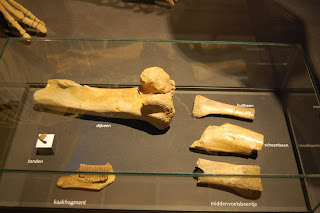 |
| It's a duck-billed dinosaur |
Because such remains are so rare in the Netherlands all of bones would probably fit into a single display, if they were all in one place. They are unfortunately not all in the same place, but the NHHM in Maastricht has a relatively large number of them.
 |
| A few teeth, a jaw fragment and some broken bones. |
Because such a display is not very impressive the NHMM had a reconstruction made. And although the bones are non-diagnostic they are definitely hadrosaurid, they were a close match for the Russian hadrosaur Amurosaurus. This along with some other hadrosaur skeletons became the model for the mount, with a dab of speculation to make it unique (that headcrest? Purely speculative).
 |
| The NHHM hadrosaur, hiding behind a column |
It's a very neat display, that gives a good impression of what a smallish hadrosaur would have looked like. But the exhibit is also rather sparse, and if I had come here not already knowing quite a bit about dinosaurs and this particular mount I would not have gotten all that much out of it.
 |
| It looks a little like Cretaceous cow. |
And come to think of it, I have some unanswered questions. The mount is clearly quadrupedal, but surely it would have spent a lot of time on just two legs. Or maybe it didn't. There's nothing here to tell me anything about behaviour at all (except the very generic claim that this was a herbivore).
 |
| Butt view (why this important) |
What I also missed was more information about what is real and what isn't, visitors who come here without first reading up on the mount and it's history can be forgiven for thinking this is all actual dinosaur bone. And by implication this is what a dinosaur looks like when it's discovered.
That is disappointing, especially since it makes for a good story (which is actually captured in a book called "De Nederlandse Dino"). Connecting the disparate bones with the mount would also be very informative.
 |
| Bones and reconstruction |

Do you have any idea how this dinosaur looked from the outside? Dit it have feathers? Maybe one of the musea can make a reconstruction..!
ReplyDeleteWe know quite a bit about hadrosaur skin, thanks to hadrosaur mummies (http://www.history.nd.gov/exhibits/dinomummy.html). No feathers as far as we know, but the scaly hide traditionally associated with Dinosaurs.
ReplyDeleteThe museum actually had a life reconstruction commissioned, but it was done by someone with experience in human anatomy only. And so it looks more like a mammal than a dinosaur!
http://vorige.nrc.nl/multimedia/archive/00124/Drijflijk_uit_de_z_124905a.jpeg